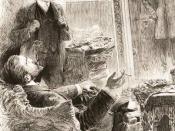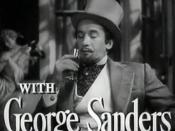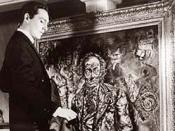Oscar Wilde, the author of "The Picture of Dorian Gray", makes Basil's life change drastically by having him paint a portrait of Dorian Gray and expresses too much of himself in it, which, in Wilde's mind, is a troublesome obstacle to circumvent. Wilde believes that the artist should not portray any of himself in his work, so when Basil does this, it is he who creates his own downfall, not Dorian.
Wilde introduces Basil to Dorian when Basil begins to notice Dorian staring at him at a party. Basil "suddenly became conscious that someone was looking at him. He turned halfway around and saw Dorian Gray for the first time" (24). Basil immediately notices him, however Basil is afraid to talk to him. His reason for this is that he does "not want any external influence in his life" (24). This is almost a paradox in that it is eventually his own internal influence that destroys him.
Wilde does this many times throughout the book. He loved using paradoxes and that is why Lord Henry, the character most similar to Wilde, is quoted as being called "Price Paradox." Although Dorian and Basil end up hating each other, they do enjoy meeting each other for the first time. Basil finds something different about Dorian. He sees him in a different way than he sees other men. Dorian is not only beautiful to Basil, but he is also gentle and kind. This is when Basil falls in love with him and begins to paint the picture.
Basil begins painting the picture, but does not tell anyone about it, including Dorian, because he knows that there is too much of himself in it. Lord Henry discovers the painting and asks Basil why he will not display it. Lord Henry thinks...


